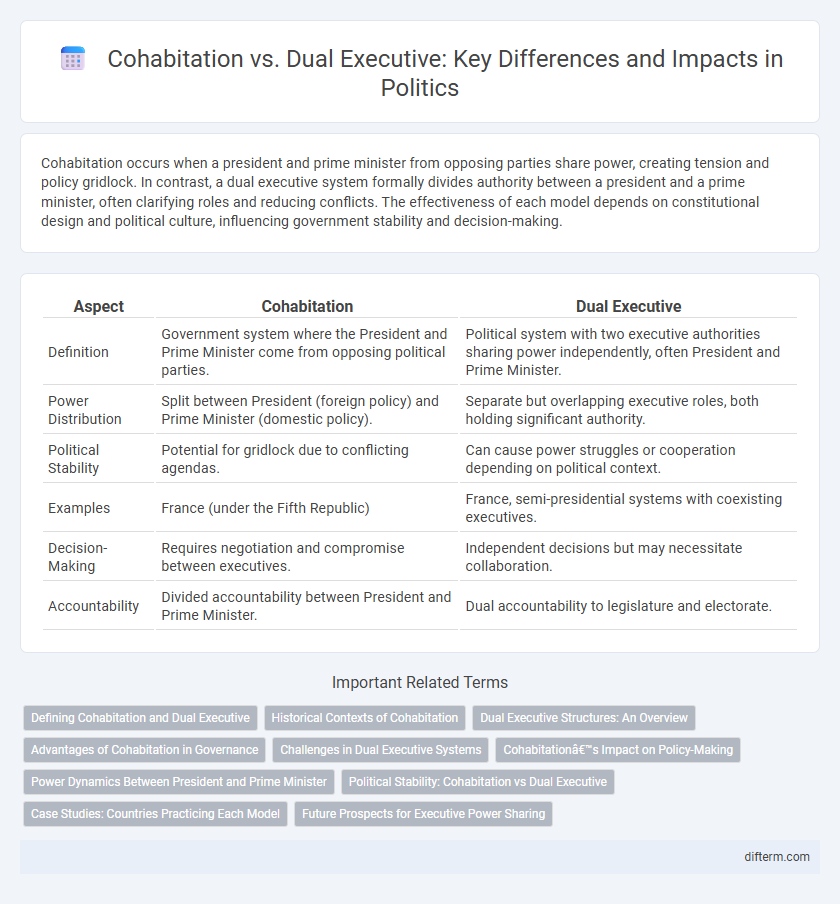Cohabitation occurs when a president and prime minister from opposing parties share power, creating tension and policy gridlock. In contrast, a dual executive system formally divides authority between a president and a prime minister, often clarifying roles and reducing conflicts. The effectiveness of each model depends on constitutional design and political culture, influencing government stability and decision-making.
Table of Comparison
| Aspect | Cohabitation | Dual Executive |
|---|---|---|
| Definition | Government system where the President and Prime Minister come from opposing political parties. | Political system with two executive authorities sharing power independently, often President and Prime Minister. |
| Power Distribution | Split between President (foreign policy) and Prime Minister (domestic policy). | Separate but overlapping executive roles, both holding significant authority. |
| Political Stability | Potential for gridlock due to conflicting agendas. | Can cause power struggles or cooperation depending on political context. |
| Examples | France (under the Fifth Republic) | France, semi-presidential systems with coexisting executives. |
| Decision-Making | Requires negotiation and compromise between executives. | Independent decisions but may necessitate collaboration. |
| Accountability | Divided accountability between President and Prime Minister. | Dual accountability to legislature and electorate. |
Defining Cohabitation and Dual Executive
Cohabitation in politics occurs when the president and the prime minister come from different political parties, sharing executive power but often leading to policy compromises. A dual executive system divides authority between a president and a prime minister, each with distinct constitutional powers, preventing concentration of power in one office. This separation aims to balance political influence and ensure accountability within government structures.
Historical Contexts of Cohabitation
Cohabitation in politics emerged prominently in France during the Fifth Republic, particularly after the 1986 legislative elections when President Francois Mitterrand, a Socialist, was forced to appoint Jacques Chirac, a Gaullist, as Prime Minister. This period highlighted the complexities of sharing executive power under a semi-presidential system, contrasting sharply with the dual executive model where distinct powers are clearly divided between president and prime minister. Historical examples of cohabitation demonstrate the system's capacity to foster political compromise but also reveal challenges in policy coherence and governance stability.
Dual Executive Structures: An Overview
Dual executive structures feature a division of power between a head of state and a head of government, each with distinct constitutional responsibilities. In many parliamentary systems, the president handles foreign affairs and symbolic duties, while the prime minister manages domestic policy and government operations. This separation can enhance checks and balances but may also lead to policy gridlock, especially when the two executives come from opposing political parties.
Advantages of Cohabitation in Governance
Cohabitation in governance allows for a balance of power between the President and Prime Minister, reducing the risk of authoritarianism by ensuring that executive decisions undergo rigorous scrutiny. This system fosters political pluralism and accountability, as divergent party interests promote negotiation and compromise in policy-making. Enhanced checks and balances inherent in cohabitation can lead to more stable and representative governance by preventing unilateral decision-making.
Challenges in Dual Executive Systems
Dual executive systems often face significant challenges in balancing power between the president and prime minister, leading to potential conflicts and political gridlock. These challenges are exacerbated when the two executives represent opposing political parties, complicating decision-making processes and policy implementation. Power struggles in such systems can undermine governmental stability and reduce administrative efficiency.
Cohabitation’s Impact on Policy-Making
Cohabitation in political systems occurs when the president and prime minister come from opposing parties, leading to a power-sharing dynamic that often complicates policy-making. This division can result in legislative gridlock, slowing down the enactment of laws due to conflicting political agendas. However, cohabitation may also encourage compromise, fostering policies that reflect broader consensus across party lines.
Power Dynamics Between President and Prime Minister
Cohabitation occurs when the President and Prime Minister come from opposing political parties, creating a unique power dynamic that forces negotiation and compromise. In dual executive systems, the division of authority between the President, often head of state, and the Prime Minister, head of government, delineates clear boundaries but can lead to overlapping responsibilities. The balance of power depends heavily on institutional frameworks, constitutional provisions, and political contexts, influencing how executive functions are shared or contested.
Political Stability: Cohabitation vs Dual Executive
Political stability under cohabitation often experiences fluctuations as differing party agendas may lead to legislative gridlock and policy inconsistency. In contrast, a dual executive system, where powers are clearly delineated between president and prime minister, can promote stability by balancing authority and fostering cooperation. Empirical studies indicate that cohabitation tends to increase political tension, whereas dual executive frameworks with clear constitutional roles reduce conflict and support sustained governance.
Case Studies: Countries Practicing Each Model
France exemplifies cohabitation with a president and prime minister from opposing parties sharing executive power, often leading to policy compromises and power struggles. In contrast, the United States represents a dual executive system where the president combines the roles of head of state and government, centralizing executive authority. Other countries like South Korea exhibit hybrid characteristics, showcasing variations in power distribution within executive frameworks.
Future Prospects for Executive Power Sharing
Future prospects for executive power sharing indicate a growing trend toward flexible governance models that balance authority between cohabitation and dual executive systems. Political stability and effective policy implementation rely on clear constitutional frameworks that delineate the powers of presidents and prime ministers, minimizing conflicts during cohabitation periods. Emerging democracies are increasingly adopting hybrid executive structures to enhance cooperation and accountability, reflecting global shifts in executive power dynamics.
cohabitation vs dual executive Infographic

 difterm.com
difterm.com